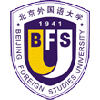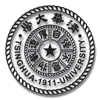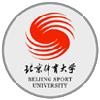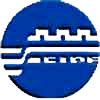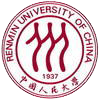Beijing Transportation
Beijing follows a concentric layout. At the heart of Beijing is the Forbidden
City, which lies literally in the city's core. Then there are the Ring
Roads, which encircle the city and are the major commuting arteries. The
Second and Third Ring Roads are the main freeway for getting around in
the city and downtown. The Fourth and Fifth Ring Roads lies further out,
and are useful for commuting to the airport and outlying suburbs. When
in Beijing, there are different options on how to get around.
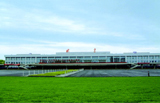 Several dozen foreign air companies have set up offices in Beijing. You
can fly to Beijing from major cities within China, and from 54 cities in
39 countries worldwide. Several dozen foreign air companies have set up offices in Beijing. You
can fly to Beijing from major cities within China, and from 54 cities in
39 countries worldwide.
Name of Beijing Airport: Beijing Capital Airport
Distance from City Core: 30km
Information desk: (8610) 6456-3604
Booking a domestic flight: (8610) 6601-3336
Booking an international flight: (8610) 6601-6667
| Air China (CA) |
(8610) |
6601-3336 |
| Air France (AF) |
(8610) |
6588-1388 |
| Air Russia (SU) |
(8610) |
6500-2412 |
| Austrian Airlines (OS) |
(8610) |
6462-2161 |
| British Airway (BA) |
(8610) |
6512-4080 |
| Canadian Airlines (CP) |
(8610) |
6468-2001 |
| Southwest Airline (MU) |
(8610) |
6601-7579 |
| Dutch Airlines (KLM) |
(8610) |
6505-3505 |
| Finnair (AY) |
(8610) |
6512-7180 |
| Japan Airlines (JL) |
(8610) |
6513-0888 |
| Korean Air (AZ/KE) |
(8610) |
6505-0088 |
| Lufthansa (LH) |
(8610) |
6465-4488 |
| Macao Air (NX) |
(8610) |
6515-8988 |
| Northwest Airlines (NW) |
(8610) |
6505-3505 |
| Singapore Airlines (SQ) |
(8610) |
6505-2233 |
| South China Airline (CZ) |
(8610) |
6601-7755-2142 |
| Swissair (SR) |
(8610) |
6512-3555 |
| Thai International (TG) |
(8610) |
6460-8899 |
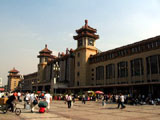 The train system is well developed. It links Beijing with China's major
cities and autonomous regions (including Shenzhen and Hong Kong), and even
international cities. The train system is well developed. It links Beijing with China's major
cities and autonomous regions (including Shenzhen and Hong Kong), and even
international cities.
Tickets can be booked during peak season or buy fromm travel agents or
directly from train stations.
From within Mainland China, tickets can be purchased at one of the local
train stations. From Hong Kong, tickets can be purchased through
one of the China Travel Service outlets.
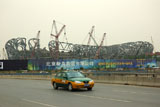 Beijing enjoys 24-hour taxi service. Taxi is the preferred transportation choice for most foreigners, because it isn't expensive and it is easy to hail one. A taxi ride costs RMB 10 for the first 4 or 5 km and RMB 2.5 for each additional km. Fares vary depending on the type of taxicabs chosen (from regular to luxurious sedans), but the fares are always clearly marked on the taxi window. When in a taxi, make sure the meter is on. Each taxi is fitted with a computerized fare meter to calculate distance and costs. For a journey that takes longer than 10 kilo or running after 11:00 pm, the fares charged will be slightly higher. Passengers pay for the bridge and road tolls.
Most taxi drivers do not understand much English, although those in tourist cities are encouraged to learn and speak some simple English. Non-Chinese speaking visitors are advised to have their destinations written down in Chinese and show it to the cab driver. Beijing enjoys 24-hour taxi service. Taxi is the preferred transportation choice for most foreigners, because it isn't expensive and it is easy to hail one. A taxi ride costs RMB 10 for the first 4 or 5 km and RMB 2.5 for each additional km. Fares vary depending on the type of taxicabs chosen (from regular to luxurious sedans), but the fares are always clearly marked on the taxi window. When in a taxi, make sure the meter is on. Each taxi is fitted with a computerized fare meter to calculate distance and costs. For a journey that takes longer than 10 kilo or running after 11:00 pm, the fares charged will be slightly higher. Passengers pay for the bridge and road tolls.
Most taxi drivers do not understand much English, although those in tourist cities are encouraged to learn and speak some simple English. Non-Chinese speaking visitors are advised to have their destinations written down in Chinese and show it to the cab driver.
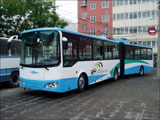 Public city buses run from 5:30 am till 11:00 pm daily. Taking buses in
Beijing is really inexpensive (ranging from RMB 1 to RMB 2), but they are
less comfortable and run slower than taxis or subways. The flat rate for
an electric car and ordinary public car is RMB 1. Buses equipped with
air-conditioning or of special line are charged according to the distance. Public city buses run from 5:30 am till 11:00 pm daily. Taking buses in
Beijing is really inexpensive (ranging from RMB 1 to RMB 2), but they are
less comfortable and run slower than taxis or subways. The flat rate for
an electric car and ordinary public car is RMB 1. Buses equipped with
air-conditioning or of special line are charged according to the distance.
Few foreigners like getting around by bus, because it is always crowded,
especially during rush hours (6:30am -9:00 am and 5:00 pm -7:00pm).
More bus driver's assistants are beginning to offer stop's name in English
but they don't know much more English beyond that.
Writing down some commonly used Chinese sentences is therefore quite helpful.
Minibuses, operating from 7:00 am to 7:00 pm, charge the flat rate of RMB
2 to guarantee a seat. They are faster and more comfortable. In crowded
settings, be careful of your belongings.
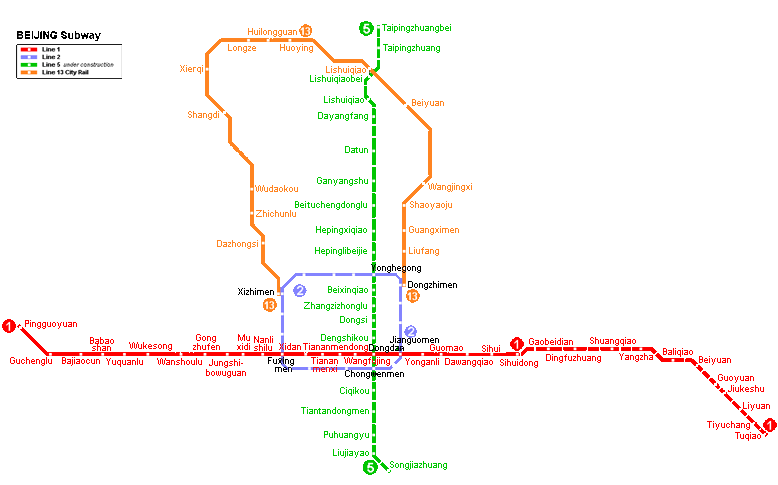 Beijing's subway is very clean, fast and quite comfortable. During rush
hours and weekends, however, the subway is generally crowded. The subway
runs every 4 or 5 minutes daily from 5:00 am to 10:00 pm or 11:30 pm, depending
on different lines. There are two subway lines in Beijing, which cross
each other at Fuxingmen or Jianguomen Terminals where passengers can transit
from one line to the other without going out of the station or paying a
transfer fee. Operation hours: 5:00 am - 10:30 pm and fare per person
is RMB 3. Beijing's subway is very clean, fast and quite comfortable. During rush
hours and weekends, however, the subway is generally crowded. The subway
runs every 4 or 5 minutes daily from 5:00 am to 10:00 pm or 11:30 pm, depending
on different lines. There are two subway lines in Beijing, which cross
each other at Fuxingmen or Jianguomen Terminals where passengers can transit
from one line to the other without going out of the station or paying a
transfer fee. Operation hours: 5:00 am - 10:30 pm and fare per person
is RMB 3.
There is also a Sky Train available now taking you to the Northwestern
part of Beijing. You can transfer onto the Sky Train from the subway stations
at Dongzhimen or Xizhimen. Riding the Sky Train only is RMB 3 per person;
or RMB 5 for riding both the Sky Train and Subway.
To view subway map, please click here.
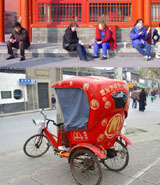 The smooth and extensive roads of Beijing have given rise to a unique
and fascinating tourist service. Pedicab (rickshaw like bicycle)
is a good choice for sightseeing, especially for visiting hutongs. The
cost per ride varies depending on your bargaining abilities. You must
first bargain with the driver, ask him how much it will cost ("duo
shao qian" in Chinese), make everything clear (i.e. one way or round
trip; US dollars or RMB) before getting on. , The legally registered pedicabs
can be identified as they have a certificate stuck on it, and
the driver has an ID card hung around his neck. The smooth and extensive roads of Beijing have given rise to a unique
and fascinating tourist service. Pedicab (rickshaw like bicycle)
is a good choice for sightseeing, especially for visiting hutongs. The
cost per ride varies depending on your bargaining abilities. You must
first bargain with the driver, ask him how much it will cost ("duo
shao qian" in Chinese), make everything clear (i.e. one way or round
trip; US dollars or RMB) before getting on. , The legally registered pedicabs
can be identified as they have a certificate stuck on it, and
the driver has an ID card hung around his neck.
China used to be called the sea of bicycles and in Beijing today, they
are still a convenient form of transportation for most people in the city.
Tourists may also choose to ride a bicycle into the city's numerous back
alleys and hutongs to discover or experience local customs and habits.
You can rent bicycles for RMB 20-30 per day, or buy a pretty reliable one
from RMB 150-500. Parking your bike is easy as there are many places to
park bikes all over the city and the charge for this service is less than
RMB 1.
Today you can travel around certain places by water in Beijing. Two courses
are available: Changhe course and Kunyuhe course. Additionally, tourist
boats available in Shichahai.
Changhe Course
This course is 9 kilometers long, running from the lake Kunmen Hu to the lake
Beizhanhou Hu. By boat you will pass Yiheyuan dock, Changhewan dock, Wanshou
Temple, Ziyuwan dock, Zizhuyuan Park, Beijing Library, Beijing Zoo, Beijing Aquarium,
Beijing Exhibition Hall, Maizhong bridge, Guangyuanzha, Five Pagoda Temple (Wuta
Si), Gaoliang Qiao, and so on. This course used to be the channel by which the
Imperial Family went westwards to take their summers. Daily boat rides start
from Beizhanhou Hu at 9:30 am, 1:00 pm, and 3:30 pm; and from Yiheyuan at 10:45
am and 2:15 pm.
Kunyu Course
This course runs 10 kilometers from Kunmen Hu to Yuyuan Tan, passing Yiheyuan
dock, Changhewan dock, Linglong Park, Enji Park, Benjiaoyuan dock, CCTV tower
dock, Yuyuan Tan (Bayi Hu dock), Aquatic Fairyland, Song Qingling Children's
Park, and more. Later the course extends to include Gaobeidian Hu, where visitors
will be able to enjoy more scenic spots, like White Cloud Taoist Temple (Baiyun
Guan), Tianning Temple, Grand View Garden, Temple of Heaven, Longtan Hu Park,
and so on. Boats depart Bayi Hu at 8 am, 9 am, 10 am, 1 pm, 3 pm and 4:30 pm;
and from Yiheyuan at 9:05 am, 10:05 am, 11:05 am, 2:05 pm and 4:05 pm.
In Shichahai, apart from the Hutong Tour, you can also travel by a southern
style boat with a long scull and fully enjoy the old traditional form of
travel.
Course 1 goes from the back gate of Beihai, to Drum Tower, Yinding Bridge, Hutong
Tour and then back to Beihai.
Course 2 goes from the back gate of Baihai, to Shichahai Front Water, Yinding
Bridge, Shichahai Back Water, Hutong Tour and ending at Gongwangfu Garden.
NOTE:
Although this information is correct at the time of our web publication,
it is still advised that you call the phone number and confirm
the address before going to the venue because some venues may
have changed their telephone numbers or address locations.
|
 Beijing enjoys 24-hour taxi service. Taxi is the preferred transportation choice for most foreigners, because it isn't expensive and it is easy to hail one. A taxi ride costs RMB 10 for the first 4 or 5 km and RMB 2.5 for each additional km. Fares vary depending on the type of taxicabs chosen (from regular to luxurious sedans), but the fares are always clearly marked on the taxi window. When in a taxi, make sure the meter is on. Each taxi is fitted with a computerized fare meter to calculate distance and costs. For a journey that takes longer than 10 kilo or running after 11:00 pm, the fares charged will be slightly higher. Passengers pay for the bridge and road tolls.
Most taxi drivers do not understand much English, although those in tourist cities are encouraged to learn and speak some simple English. Non-Chinese speaking visitors are advised to have their destinations written down in Chinese and show it to the cab driver.
Beijing enjoys 24-hour taxi service. Taxi is the preferred transportation choice for most foreigners, because it isn't expensive and it is easy to hail one. A taxi ride costs RMB 10 for the first 4 or 5 km and RMB 2.5 for each additional km. Fares vary depending on the type of taxicabs chosen (from regular to luxurious sedans), but the fares are always clearly marked on the taxi window. When in a taxi, make sure the meter is on. Each taxi is fitted with a computerized fare meter to calculate distance and costs. For a journey that takes longer than 10 kilo or running after 11:00 pm, the fares charged will be slightly higher. Passengers pay for the bridge and road tolls.
Most taxi drivers do not understand much English, although those in tourist cities are encouraged to learn and speak some simple English. Non-Chinese speaking visitors are advised to have their destinations written down in Chinese and show it to the cab driver.

 Several dozen foreign air companies have set up offices in Beijing. You
can fly to Beijing from major cities within China, and from 54 cities in
39 countries worldwide.
Several dozen foreign air companies have set up offices in Beijing. You
can fly to Beijing from major cities within China, and from 54 cities in
39 countries worldwide. The train system is well developed. It links Beijing with China's major
cities and autonomous regions (including Shenzhen and Hong Kong), and even
international cities.
The train system is well developed. It links Beijing with China's major
cities and autonomous regions (including Shenzhen and Hong Kong), and even
international cities. Public city buses run from 5:30 am till 11:00 pm daily. Taking buses in
Beijing is really inexpensive (ranging from RMB 1 to RMB 2), but they are
less comfortable and run slower than taxis or subways. The flat rate for
an electric car and ordinary public car is RMB 1. Buses equipped with
air-conditioning or of special line are charged according to the distance.
Public city buses run from 5:30 am till 11:00 pm daily. Taking buses in
Beijing is really inexpensive (ranging from RMB 1 to RMB 2), but they are
less comfortable and run slower than taxis or subways. The flat rate for
an electric car and ordinary public car is RMB 1. Buses equipped with
air-conditioning or of special line are charged according to the distance.  Beijing's subway is very clean, fast and quite comfortable. During rush
hours and weekends, however, the subway is generally crowded. The subway
runs every 4 or 5 minutes daily from 5:00 am to 10:00 pm or 11:30 pm, depending
on different lines. There are two subway lines in Beijing, which cross
each other at Fuxingmen or Jianguomen Terminals where passengers can transit
from one line to the other without going out of the station or paying a
transfer fee. Operation hours: 5:00 am - 10:30 pm and fare per person
is RMB 3.
Beijing's subway is very clean, fast and quite comfortable. During rush
hours and weekends, however, the subway is generally crowded. The subway
runs every 4 or 5 minutes daily from 5:00 am to 10:00 pm or 11:30 pm, depending
on different lines. There are two subway lines in Beijing, which cross
each other at Fuxingmen or Jianguomen Terminals where passengers can transit
from one line to the other without going out of the station or paying a
transfer fee. Operation hours: 5:00 am - 10:30 pm and fare per person
is RMB 3.  The smooth and extensive roads of Beijing have given rise to a unique
and fascinating tourist service. Pedicab (rickshaw like bicycle)
is a good choice for sightseeing, especially for visiting hutongs. The
cost per ride varies depending on your bargaining abilities. You must
first bargain with the driver, ask him how much it will cost ("duo
shao qian" in Chinese), make everything clear (i.e. one way or round
trip; US dollars or RMB) before getting on. , The legally registered pedicabs
can be identified as they have a certificate stuck on it, and
the driver has an ID card hung around his neck.
The smooth and extensive roads of Beijing have given rise to a unique
and fascinating tourist service. Pedicab (rickshaw like bicycle)
is a good choice for sightseeing, especially for visiting hutongs. The
cost per ride varies depending on your bargaining abilities. You must
first bargain with the driver, ask him how much it will cost ("duo
shao qian" in Chinese), make everything clear (i.e. one way or round
trip; US dollars or RMB) before getting on. , The legally registered pedicabs
can be identified as they have a certificate stuck on it, and
the driver has an ID card hung around his neck.